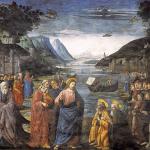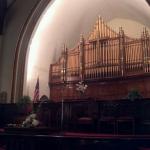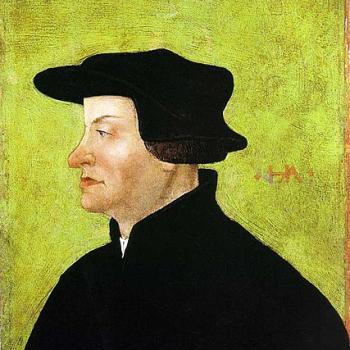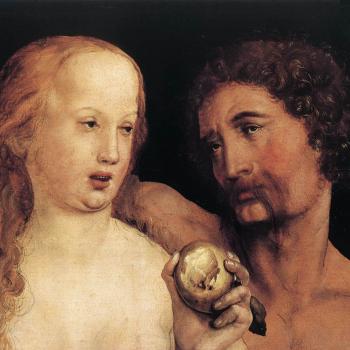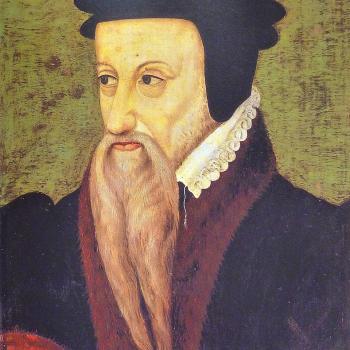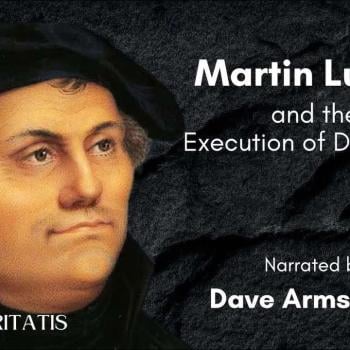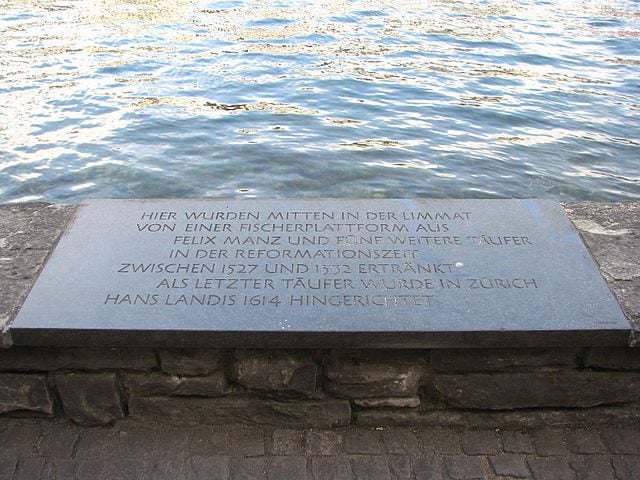
* * * * *
Historical facts are what they are, and most Protestants (and Catholics) are unaware of the following historical events and beliefs (while, on the other hand, one always hears about the embarrassing and scandalous Catholic stuff — and not often very accurately or fairly at that). If (as I suspect might often be the case) readers are shocked or surprised by the very title of this paper, this would be a case in point, and justification enough for my purposes of education.
Even James Swan, an anti-Catholic Reformed Protestant polemicist and controversialist, who has often incompetently and unfairly savaged my research on early Protestantism, freely admits:
***
***
* * * * *
[P = Protestant scholar / S = secularist / non-religious scholar; otherwise, Catholics]
***
*
If any one still harbors the traditional prejudice that the early Protestants were more liberal, he must be undeceived. Save for a few splendid sayings of Luther, confined to the early years when he was powerless, there is hardly anything to be found among the leading reformers in favor of freedom of conscience. As soon as they had the power to persecute they did. (Preserved Smith [S], 177)
The Reformers themselves . . . e.g., Luther, Beza, and especially Calvin, were as intolerant to dissentients as the Roman Catholic Church. (Cross, Oxford Dictionary of the Christian Church [P], 1383)
Protestants . . . read blood-curdling stories of the Inquisition and of atrocities committed by Catholics, but what does the average Protestant know of Protestant atrocities in the centuries succeeding the Reformation? Nothing, unless he makes a special study of the subject . . . Yet they are perfectly well known to every scholar . . .
Now granting for the sake of argument, that all that is usually said of Catholic persecutions is true, the fact remains that Protestants, as such, have no right to denounce them, as if such deeds were characteristic of Catholics only. People who live in glass houses should not throw stones . . . It is unquestionable . . . that the champions of Protestantism – Luther, Calvin, Beza, Knox, Cranmer and Ridley — advocated the right of the civil authorities to punish the ‘crime’ of heresy . . . Rousseau says truly: “The Reformation was intolerant from its cradle, and its authors were universal persecutors . . .” Auguste Comte also writes: “The intolerance of Protestantism was certainly not less tyrannical than that with which Catholicism is so much reproached.” (Philosophie Positive, IV, 51)
What makes, however, Protestant persecutions specially revolting is the fact that they were absolutely inconsistent with the primary doctrine of Protestantism — the right of private judgment in matters of religious belief! Nothing can be more illogical than at one moment to assert that one may interpret the Bible to suit himself, and at the next to torture and kill him for having done so! . . .
At all events, the argument that the persecutions for heresy, perpetrated by the Catholics, constitute a reason why one should not enter the Catholic Church, has not a particle more force than a similar argument would have against one’s entering the Protestant Church. In both there have been those deserving of blame in this respect, and what applies to one applies also to the other. (Stoddard, 204-205, 209-210)
The ablest defence of persecution during the 17th century came from the Scottish Presbyterian Samuel Rutherford (A Free Disputation Against Pretended Liberty Of Conscience, 1649). (Chadwick [P], 403)
In England the advocates of religious toleration long continued to be in a minority, but it was . . . defended by J. Milton in his Areopagitica [1644] (to the exclusion, however of RCs) . . . It virtually became the policy of the state by the Act of Toleration (q.v.) of 1689, which excluded only RCs and Unitarians. In the same year Locke published his first Letter concerning Toleration, to be followed by three others, denying the state all right of interference in religious matters and demanding toleration for all except RCs and atheists. (Cross, Oxford Dictionary of the Christian Church [P], 1383-1384)
Often the resistance to tyranny and the demand for religious freedom are combined, as in the Puritan revolution in England; and the victors, having achieved supremacy, then set up a new tyranny and a fresh intolerance. (Harkness [P], 222)
Multitudes of Non-Conformists fled from Ireland and England to America; . . . What is amazing is the fact that, after such experiences, those fugitives did not learn the lesson of toleration, and did not grant to those who differed . . . freedom . . . When they found themselves in a position to persecute, they tried to outdo what they had endured . . . Among those whom they attacked was . . . the Society of Friends, otherwise known as Quakers. (Stoddard, 207)
In Massachusetts, for successive convictions, a Quaker would suffer the loss of one ear and then the other, the boring of the tongue with a hot iron, and sometimes eventually death. In Boston three Quaker men and one woman were hanged. Baptist Roger Williams was banished from Massachusetts in 1635 and founded tolerant Rhode Island (Stoddard, 208).
*
To his credit, he remained tolerant, an exception to the rule, as was William Penn, who was persecuted by Protestants in England and founded the tolerant colony of Pennsylvania. Quakerism (Penn’s faith) has an honorable record of tolerance since, — like its predecessor Anabaptism –, it is one of the most subjective and individualistic of Protestant sects, and eschews association with the “world” (governments, the military, etc.), whence lies the power necessary to persecute. Thus, Quakers were in the forefront of the abolition movement in America in the first half of the 19th century. (Armstrong)
In the 17th century the most notable instances of practical toleration were the colonies of Maryland, founded by Lord Baltimore in 1632 for persecuted Catholics, which offered asylum also to Protestants, and of Rhode Island, founded by Roger Williams. (Cross, Oxford Dictionary of the Christian Church [P], 1383)
Baltimore . . . welcomed, among other English people, even the Catholic-hating Puritans . . . In January of 1691 . . . the new regime brought hard times for Catholics as the Protestants closed their church, forbade them to teach in public . . . but . . . the little outpost of practical Catholic tolerance had left its mark of promise on the land. (Martin Marty [P], Pilgrims in Their Own Land: 500 Years of Religion in America, New York: Penguin, 1984, 83, 85-86)
Lord Baltimore allowed several hundred Puritans, unwelcome in Episcopalian Virginia, to enter Maryland in 1648. (Armstrong, see Ellis, below, p. 37)
For the first time in history . . . all churches would be tolerated, and . . . none would be the agent of the government . . . Catholics and Protestants side by side on terms of equality and toleration unknown in the mother country . . . The effort proved vain; for . . . the Puritan element . . . October, 1654, repealed the Act of Toleration and outlawed the Catholics . . . condemning ten of them to death, four of whom were executed . . . From . . . 1718 down to the outbreak of the Revolution, the Catholics of Maryland were cut off from all participation in public life, to say nothing of the enactments against their religious services and . . . schools for Catholic instruction . . . During the half-century the Catholics had governed Maryland they had not been guilty of a single act of religious oppression. (John Tracy Ellis, American Catholicism, Garden City, New York: Doubleday Image, 1956, 36, 38-39)
Stories of Protestant intolerance in America prior to 1789 could be multiplied indefinitely. Jefferson and Madison, in pushing for complete religious freedom, were reacting primarily to these inter-Protestant wars for dominance, not the squabbles of post-Reformation Europe. Here we are concerned with the immediate era of the Protestant Revolution — roughly 1517 to 1600, so the above anecdotes will have to suffice as altogether typical examples. (Armstrong)
The principle which the Reformation had upheld in the youth of its rebellion — the right of private judgment — was as completely rejected by the Protestant leaders as by the Catholics . . . Toleration was now definitely less after the Reformation than before it. (Durant [S], 456; referring to the year 1555)
Melanchthon accepted the chairmanship of the secular inquisition that suppressed the Anabaptists in Germany with imprisonment or death. . . . he was convinced that God had destined all Anabaptists to hell. (Durant [S], 423)
A regular inquisition was set up in Saxony, with Melanchthon on the bench, and under it many persons were punished, some with death, some with life imprisonment, and some with exile. (Smith [S], 177)
The persecution of the Anabaptists began in Zurich . . . The penalties enjoined by the Town Council of Zurich were ‘drowning, burning, or beheading,’ according as it seemed advisable . . . ‘It is our will,’ the Council proclaimed, ‘that wherever they be found, whether singly or in companies, they shall be drowned to death, and that none of them shall be spared.’ (Janssen, V, 153-157)
In his Dialogues of 1535, Bucer called on governments to exterminate by fire and sword all professing a false religion, and even their wives, children and cattle. (Armstrong; Janssen, V, 367-368, 290-291)
His [John Knox’s] conviction . . . harked back to the darkest practices of the Inquisition . . . Every heretic was to be put to death, and cities predominantly heretical were to be smitten with the sword and utterly destroyed: “To the carnal man this may appear a . . . severe judgment . . . Yet we find no exception, but all are appointed to the cruel death. But in such cases God wills that all . . . desist from reasoning when commandment is given to execute his judgments.” (Durant [S], 614; citing Edwin Muir, John Knox, London: 1920, 142)
[Queen] Elizabeth . . . is on record for the burning of two Dutch Anabaptists in 1575. (Hughes, 143)
An English Servetus could have been burned under Elizabeth, and, in fact, in 1589 she burned an Arian. (Hughes, 274)
In the preface to the Institutes he [John Calvin] admitted the right of the government to put heretics to death . . . He thought that Christians should hate the enemies of God . . . Those who defended heretics . . . should be equally punished. (Smith [S], 178)
[During Calvin’s reign in Geneva, between 1542 and 1546] “58 persons were put to death for heresy.” (Durant [S], 473)
Melanchthon, in a letter to Calvin and Bullinger, gave ‘thanks to the Son of God’ . . . and called the burning [of Michael Servetus] ‘a pious and memorable example to all posterity.’ Bucer declared from his pulpit in Strasbourg that Servetus had deserved to be disemboweled and torn to pieces. Bullinger, generally humane, agreed that civil magistrates must punish blasphemy with death. (Durant [S], 484)
Persecution, including death penalties for heresy, is not just a Catholic failing. It is clearly also a Protestant one, and a general “blind spot” of the Middle Ages, much like abortion is in our own supposedly “enlightened” age. Furthermore, it is an outright lie to assert that Protestantism in its initial appearance, advocated tolerance. The evidence thus far presented refutes this notion beyond any reasonable doubt. (Armstrong)
*
The cities found Protestantism profitable . . . for a slight alteration in their theological garb they escaped from episcopal taxes and courts, and could appropriate pleasant parcels of ecclesiastical property . . . The princes . . . could be spiritual as well as temporal lords, and all the wealth of the Church could be theirs . . . The Lutheran princes suppressed all monasteries in their territory except a few whose inmates had embraced the Protestant faith. (Durant [S], 438-439)
In Sweden Gustavus Vasa deprived the Church of all its landed properties . . . The proportion of land held by the crown increased during his reign from 5.5% to 28%: that of the Church from 21% to nil. (Dickens [P], 191)
The great Scottish nobles . . . supported the religious revolution because it gave them the power to loot the Church and the monarchy wholesale. (Belloc, 112)
This certainly is a fine turn of affairs, if property is wickedly taken away from priests so that soldiers may make use of it in worse fashion; and the latter squander their own wealth, and sometimes that of others, so that no one benefits. (Erasmus, 157)
*
The Mass was abolished in Zurich in 1525. (Armstrong; Dickens, 117)
William Farel, who preceded Calvin in Geneva, helped to abolish the Mass in August, 1535, seize all the churches, and close its four monasteries and nunnery. (Harkness [P], 8)
His [Farel’s] sermons in St. Peter’s were the occasion of riots; statues were smashed, pictures destroyed, and the treasures of the church, to the amount of 10,000 crowns, disappeared. (Hughes, 226-227)
Martin Bucer . . . though anxious to be regarded as considerate and peaceable . . . advocated quite openly ‘the power of the authorities over consciences’. He never rested until, in 1537 . . . he brought about the entire suppression of the Mass at Augsburg. At his instigation, many fine paintings, monuments and ancient works of art in the churches were wantonly torn, broken and smashed. Whoever refused to submit and attend public worship was obliged within eight days to quit the city boundaries. Catholic citizens were forbidden under severe penalties to attend Catholic worship elsewhere . . . In other . . . cities Bucer acted with no less violence and intolerance, for instance, at Ulm, where he supported Oecolampadius . . . in 1531, and at Strasburg . . . Here, in 1529, after the Town-Council had prohibited Catholic worship, the Councillors were requested by the preachers to help fill the empty churches by issuing regulations prescribing attendance at the sermons. (Grisar, VI, 277-278)
In 1529 the Council of Strassburg also ordered the breaking in pieces of all remaining altars, images and crosses, and several churches and convents were destroyed (Janssen, V, 143-144).
*
Similar events transpired also in Frankfurt-am-Main (Durant [S], 424).
*
At a religious convention at Hamburg in April, 1535 the Lutheran towns of Lubeck, Bremen, Hamburg, Luneburg, Stralsund, Rostock and Wismar all voted to hang Anabaptists and flog Catholics and Zwinglians before banishing them (Janssen, V, 481).
*
Luther’s home territory of Saxony had instituted banishment for Catholics in 1527 (Grisar, VI, 241-242). (Armstrong)
*
In 1522 a rabble forced its way into the church at Wittenberg, on the doors of which Luther had nailed his theses, destroyed all its altars and statues, and . . . drove out the clergy. In Rotenburg also, in 1525, the figure of Christ was decapitated . . . On the 9th of February, 1529, everything previously revered in the fine old cathedral of Basle, Switzerland, was destroyed . . . Such instances of brutality and fanaticism could be cited by scores. (Stoddard, 94)
[In] Constance, on March 10, 1528, the Catholic faith was altogether interdicted . . . by the Council . . . ‘There are no rights whatever beyond those laid down in the Gospel as it is now understood’ . . . Altars were smashed . . . organs were removed as being works of idolatry . . . church treasures were to be sent to the mint. (Janssen, V, 146)
[In John Knox’s Scotland] It was . . . forbidden to say Mass or to be present at Mass, with the punishment for a first offence of loss of all goods and a flogging; for the second offence, banishment; for the third, death. (Hughes, 300)
The Protestant states did not question that teachers of disapproved doctrines should be prevented from preaching. (Chadwick [P], 398)
*
With isolated exceptions . . . we find everywhere the opinions which are exactly in harmony with those of the territorial prince of the day, striving their utmost to suppress all differing views. The theory of the absolute Church authority of the secular powers was in itself enough to make a system of tolerance impossible on the Protestant side . . . From the very first religious life among the Protestants was influenced by the hopeless contradiction that on the one hand Luther imposed it as a sacred duty on every individual, in all matters of faith, to set aside every authority, above all that of the Church, and to follow only his own judgment, while on the other hand the reformed theologians gave the secular princes power over the religion of their land and subjects . . . ‘Luther never attempted to solve this contradiction. In practice he was content that the princes should have supreme control over religion, doctrine and Church, and that it was their right and their duty to suppress every religious creed which differed from their own.’ (Janssen, XIV, 230-231; citing Johann von Dollinger: Kirche und Kirchen, 1861, 52 ff.)
The Corpus doctrinae of Melanchthon had passed muster for a long time in Saxony, but on the occasion of the crypto-Calvinistic controversies the Elector Augustus forbade the work being printed . . .; the press control, which Melanchthon had advocated against others, now hit him himself. (Janssen, XIV, 506)
In the Protestant towns numbers of preachers bestirred themselves zealously with the help of the municipal authorities to suppress the writings of all opposing parties. ‘When first Luther began to write books, it was said,’ so Frederick Staphylus recalled to mind (1560), ‘that it would be contrary to Christian freedom if the Christian folk and the common people were not allowed to read all sorts of books. Now, however . . . the Lutherans themselves are . . . forbidding the purchase and reading of the books of their opponents, and of apostate members and sects.’ (Janssen, XIV, 506-507)
Luther . . . set his pen in motion concerning this Catholic translation of the Bible. ‘The freedom of the Word,’ which he claimed for himself, was not to be accorded to his opponent Emser . . . When . . . he learnt that Emser’s translation . . . was to be printed . . . at Rostock, he not only appealed himself to his follower, Duke Henry of Mecklenburg, with the request that ‘for the glory of the evangel of Christ and the salvation of all souls’ he would put a stop to this printing, but he also worked on the councillors of the Elector of Saxony to support his action. He denied the right and the power of the Catholic authorities to inhibit his books; on the other hand he invoked the arm of the secular authorities against all writings that were displeasing to him. (Janssen, XIV, 503-504)
When the controversy on the Lord’s Supper was started at Wittenberg, the utmost precautions were taken to suppress the writings of the Swiss Reformed theologians and of the German preachers who shared the latter’s views. At the instigation of Luther and Melanchthon there was issued, in 1528, by the Elector John of Saxony, an edict to the following effect: “Books and pamphlets (of the Anabaptists, Sacramentarians, etc.) must not be allowed to be bought or sold or read . . . also those who are aware of such breaches of the orders laid down herein, and do not give information, shall be punished by loss of life and property.” (Armstrong; Janssen, XIV, 232-233; BR, IV, 549)
Melanchthon demanded in the most severe and comprehensive manner the censure and suppression of all books that were hindering to Lutheran teaching. The writings of Zwingli and the Zwinglians were placed formally on the Index at Wittenberg. (Armstrong; Janssen, XIV, 504; cf. Durant [S], 424)
At Strassburg Catholic writings were suppressed as early as 1524 . . . The Council at Frankfort-on-the-Main exercised . . . strict censorship . . . At Rostock, in 1532, the printer of the Brethren of the Common Life was sent to prison, because he had used his printing press to the disadvantage of Protestantism. (Janssen, XIV, 502)
[P = Protestant work / S = secular work / C = Catholic]
BR = Bretschneider, editor, Corpus Reformation, Halle, 1846.
Hilaire Belloc (C), Characters of the Reformation, Garden City, New York: Doubleday Image, 1958.
Owen Chadwick (P), The Reformation, New York: Penguin, revised edition, 1972.
F. L. Cross & E. A. Livingstone, editors (P), The Oxford Dictionary of the Christian Church, Oxford: Oxford University Press, 2nd edition, 1983.
A. G. Dickens (P), Reformation and Society in 16th-Century Europe, London: Harcourt, Brace & World, 1966.
Will Durant (S), The Reformation, (volume 6 of 10-volume The Story of Civilization, 1967), New York: Simon & Schuster, 1957.
Desiderius Erasmus (C), Christian Humanism and the Reformation, (selections from Erasmus), edited and translated by John C. Olin, New York: Harper & Row, 1965 (originally 1515-34).
Hartmann Grisar, S. J. (C), Luther, translated by E. M. Lamond, edited by Luigi Cappadelta, six volumes, London: Kegan Paul, Trench, Trubner & Co., 1917. [available online]
Georgia Harkness (P), John Calvin: The Man and His Ethics, New York: Abingdon Press, 1931.
Philip Hughes (C), A Popular History of the Reformation, Garden City, New York: Doubleday Image, 1957.
Johannes Janssen (C), History of the German People From the Close of the Middle Ages, 16 volumes, translated by A. M. Christie, St. Louis: B. Herder, 1910 (originally 1891). [available online]
Preserved Smith (S), The Social Background of the Reformation, New York: Collier Books, 1962 (2nd part of author’s The Age of the Reformation, New York: 1920).
John L. Stoddard (C), Rebuilding a Lost Faith, New York: P. J. Kenedy & Sons, 1922.
***
Related Reading:
Protestantism: Historic Persecution & Intolerance (My Web Page)
Luther Favored the Death Penalty for Anabaptists
Luther’s Inflammatory Rhetoric & the Peasants’ Revolt (1524-1525)
Was Luther “Bloodthirsty” & Violent? (James Swan & I Agree!)
Luther Film (2003): Detailed Catholic Critique
Zwingli, Bucer, Oecolampadius: Luther & Lutherans Not Christians
Philip Melanchthon: Death for Denying the Real Presence (He Later Denied the Real Presence Himself)
John Calvin: Capital Punishment for “Heretics” (Anabaptists, Etc.)
John Calvin: Torment of an Inept Execution “Special Will of God”
Calvin the “Destroyer” of Servetus: James Swan Misses Forest for Trees
Calvin Supports Death Penalty for Heresy After Servetus
Early Protestant “Unity”: Calvin vs. Westphal vs. Luther
444 Irish Catholic Martyrs & Heroic Confessors
“Reformation” Theft of Thousands of Catholic Churches
16th Century Theft of Church Properties (vs. Lutheran Historian)
Dialogue on Jihadist & 16th Century Calvinist Iconoclasm (vs. David Scott)
Photo credit: Zürich-Schipfe quarter : Memorial plate for the Anabaptists, murdered in early 16th century by the Zürich city government: “Here in the middle of the River Limmat from a fishing platform were drowned Felix Manz and five other Anabaptists during the Reformation of 1527 to 1532. Hans Landis, the last Anabaptist, was executed in Zurich during 1614.” Photo by Roland zh (4-10-10) [Wikimedia Commons / Creative Commons Attribution-Share Alike 3.0 Unported license]
***


